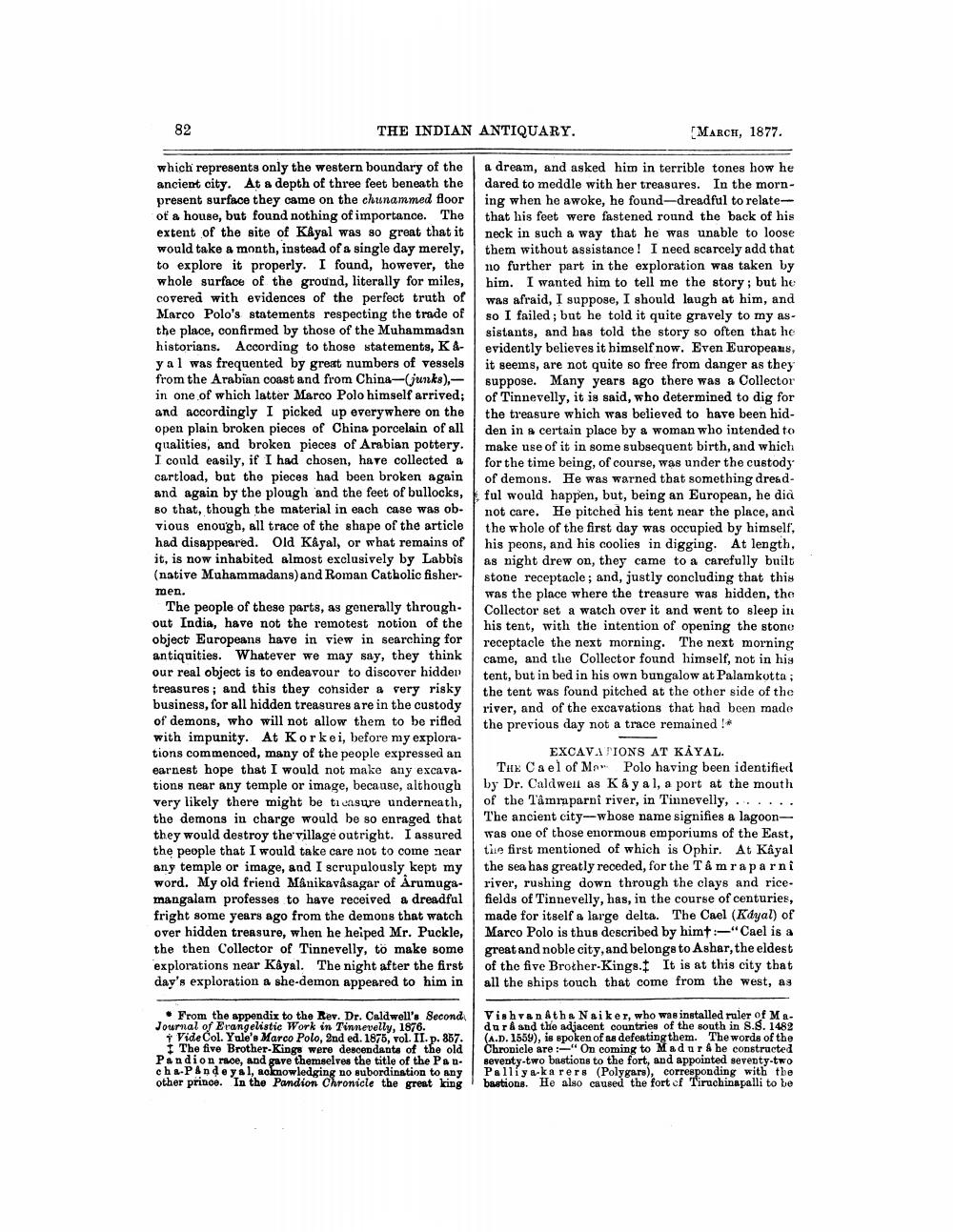________________
82
THE INDIAN ANTIQUARY.
which represents only the western boundary of the ancient city. At a depth of three feet beneath the present surface they came on the chunammed floor of a house, but found nothing of importance. The extent of the site of Kayal was so great that it would take a month, instead of a single day merely, to explore it properly. I found, however, the whole surface of the ground, literally for miles, covered with evidences of the perfect truth of Marco Polo's statements respecting the trade of the place, confirmed by those of the Muhammadan historians. According to those statements, K &y al was frequented by great numbers of vessels from the Arabian coast and from China-(junks),in one of which latter Marco Polo himself arrived; and accordingly I picked up everywhere on the open plain broken pieces of China porcelain of all qualities, and broken pieces of Arabian pottery. I could easily, if I had chosen, have collected a cartload, but the pieces had been broken again and again by the plough and the feet of bullocks, so that, though the material in each case was ob vious enough, all trace of the shape of the article had disappeared. Old Kayal, or what remains of it, is now inhabited almost exclusively by Labbis (native Muhammadans) and Roman Catholic fisher
men.
The people of these parts, as generally through. out India, have not the remotest notion of the
object Europeans have in view in searching for antiquities. Whatever we may say, they think our real object is to endeavour to discover hidden treasures; and this they consider a very risky business, for all hidden treasures are in the custody of demons, who will not allow them to be rifled with impunity. At Korkei, before my explorations commenced, many of the people expressed an earnest hope that I would not make any excava tions near any temple or image, because, although very likely there might be treasure underneath, the demons in charge would be so enraged that they would destroy the village outright. I assured the people that I would take care not to come near any temple or image, and I scrupulously kept my word. My old friend Mânikavasagar of Arumugamangalam professes to have received a dreadful fright some years ago from the demons that watch over hidden treasure, when he heiped Mr. Puckle, the then Collector of Tinnevelly, to make some explorations near Kâyal. The night after the first day's exploration a she-demon appeared to him in
From the appendix to the Rev. Dr. Caldwell's Second Journal of Evangelistic Work in Tinnevelly, 1876.
Vide Col. Yale's Marco Polo, 2nd ed. 1875, vol. II. p. 857. The five Brother-Kings were descendants of the old Pandion race, and gave themselves the title of the Pancha-Pandeyal, acknowledging no subordination to any other prince. In the Pandion Chronicle the great king
[MARCH, 1877.
a dream, and asked him in terrible tones how he dared to meddle with her treasures. In the morning when he awoke, he found-dreadful to relatethat his feet were fastened round the back of his neck in such a way that he was unable to loose them without assistance! I need scarcely add that no further part in the exploration was taken by him. I wanted him to tell me the story; but he was afraid, I suppose, I should laugh at him, and so I failed; but he told it quite gravely to my assistants, and has told the story so often that he evidently believes it himself now. Even Europeans, it seems, are not quite so free from danger as they suppose. Many years ago there was a Collector of Tinnevelly, it is said, who determined to dig for the treasure which was believed to have been hidden in a certain place by a woman who intended to make use of it in some subsequent birth, and which for the time being, of course, was under the custody of demons. He was warned that something dreadful would happen, but, being an European, he did not care. He pitched his tent near the place, and the whole of the first day was occupied by himself, his peons, and his coolies in digging. At length, as night drew on, they came to a carefully built stone receptacle; and, justly concluding that this was the place where the treasure was hidden, the Collector set a watch over it and went to sleep in his tent, with the intention of opening the stone receptacle the next morning. The next morning came, and the Collector found himself, not in his tent, but in bed in his own bungalow at Palamkotta; the tent was found pitched at the other side of the river, and of the excavations that had been made the previous day not a trace remained !*
EXCAVATIONS AT KAYAL.
THE Cael of Ma Polo having been identified by Dr. Caldwell as K & y a 1, a port at the mouth of the Tâmraparnî river, in Tinnevelly, ... The ancient city-whose name signifies a lagoonwas one of those enormous emporiums of the East, the first mentioned of which is Ophir. At Kâyal the sea has greatly receded, for the Tâmraparni river, rushing down through the clays and ricefields of Tinnevelly, has, in the course of centuries, made for itself a large delta. The Cael (Kayal) of Marco Polo is thus described by him+:-"Cael is a great and noble city, and belongs to Ashar, the eldest of the five Brother-Kings. It is at this city that all the ships touch that come from the west, as
Vishvanatha Naiker, who was installed ruler of Madura and the adjacent countries of the south in S.S. 1482 (A.D. 1559), is spoken of as defeating them. The words of the Chronicle are:-"On coming to Madur & he constructed seventy-two bastions to the fort, and appointed seventy-two Palliya-karers (Polygars), corresponding with the bastions. He also caused the fort of Tiruchinapalli to be




